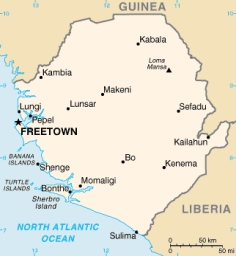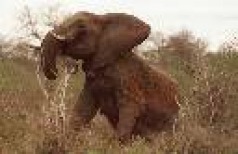Sierra Leone: Geography
by Chris Crane

Sierra Leone: Geography
Sierra Leone is a country that is hot and humid, has mountainous inlands, a swampy coastal line, and is scattered with rainforests from the coast to the middle of Sierra Leone. Just about the whole eastern part of Sierra Leone is mountainous and the highest peaks reach just above 6,000 feet (Middleton). The western part of Sierra Leone is just about at sea level with the exception of a few mountains. Sierra Leone borders Guinea to the north and Liberia to the south.Most of the cities in Sierra Leone are located right next to rivers. This is obviously so the people of Sierra Leone have water sources that are close to their cities (One-World Nations). There are over ten rivers that run through Sierra Leone, which accounts for many cities being built by them (One-World Nations). But even the cities that aren’t right on the rivers are still not far from multiple water sources (One-World Nations).
Sierra Leone is split up into four different provinces: Northern, Southern, Eastern, and Western [area] (Fage). The Western Area where Freetown, the countries capital is located, is the smallest in land size by far, but has a population almost as large as the other provinces (Fage). These provinces were formed mainly when France and Britain invaded Sierra Leone back in the 1880’s and the fact that there was a ten-year civil war that took place from 1991-2001 (Fage). Unfortunately, during the civil war poaching, not illegal then, caused some animals such as elephants, leopards, lions, hyenas, and buffalos to become very close to extinction (Fyfe). Luckily since the civil war ended poaching was declared illegal which has started to help repopulate some of these animals (Fyfe). The Elephant still happens to be close to extinction. Some of the common animals found in Sierra Leone include chimpanzees, monkeys, antelopes, and bush pigs (Fyfe). The two commonly seen animals on the coast and rivers of Sierra Leone are the crocodile and the hippo (Fyfe).
Mosquitoes are a problem in Sierra Leone because they can carry malaria, which can cause illness and death to both people and animals (CIA Fact book). One of the bigger problems in Sierra Leone is deforestation, which is caused by rapid population growth, over harvesting wood, expanding cattle grazing, and slash burning (the burning of many trees for more land) (CIA Fact book). One growing issue is Aerosol, a collection of airborne particles including gases; smoke, which looks like fog (CIA Fact book).
Sierra Leone is a country that is hot and humid, has mountainous inlands, a swampy coastal line, and is scattered with rainforests from the coast to the middle of Sierra Leone. Just about the whole eastern part of Sierra Leone is mountainous and the highest peaks reach just above 6,000 feet (Middleton). The western part of Sierra Leone is just about at sea level with the exception of a few mountains. Sierra Leone borders Guinea to the north and Liberia to the south.Most of the cities in Sierra Leone are located right next to rivers. This is obviously so the people of Sierra Leone have water sources that are close to their cities (One-World Nations). There are over ten rivers that run through Sierra Leone, which accounts for many cities being built by them (One-World Nations). But even the cities that aren’t right on the rivers are still not far from multiple water sources (One-World Nations).
Sierra Leone is split up into four different provinces: Northern, Southern, Eastern, and Western [area] (Fage). The Western Area where Freetown, the countries capital is located, is the smallest in land size by far, but has a population almost as large as the other provinces (Fage). These provinces were formed mainly when France and Britain invaded Sierra Leone back in the 1880’s and the fact that there was a ten-year civil war that took place from 1991-2001 (Fage). Unfortunately, during the civil war poaching, not illegal then, caused some animals such as elephants, leopards, lions, hyenas, and buffalos to become very close to extinction (Fyfe). Luckily since the civil war ended poaching was declared illegal which has started to help repopulate some of these animals (Fyfe). The Elephant still happens to be close to extinction. Some of the common animals found in Sierra Leone include chimpanzees, monkeys, antelopes, and bush pigs (Fyfe). The two commonly seen animals on the coast and rivers of Sierra Leone are the crocodile and the hippo (Fyfe).
Mosquitoes are a problem in Sierra Leone because they can carry malaria, which can cause illness and death to both people and animals (CIA Fact book). One of the bigger problems in Sierra Leone is deforestation, which is caused by rapid population growth, over harvesting wood, expanding cattle grazing, and slash burning (the burning of many trees for more land) (CIA Fact book). One growing issue is Aerosol, a collection of airborne particles including gases; smoke, which looks like fog (CIA Fact book).
Bibliography
Fage, John. Colonization in Western Africa. 2008. 28 April 2009 <http://www.britannica.com/EBmedia/49/5049-004-C1B754E.gif>.
This website gave me some good history on Sierra Leone’s land
Fyfe, Christopher. Plant & Animal Life. 1 January 2009. 28 April 2009 <http://www.britannice.com/EBchecked/topic/543356/Sierra-Leone>.
Is good for finding out what the different kinds of animals are
Middleton, John. Africa. Encyclopedia for Students. Volume 4. 2002
I got some decent info from this book.
Nations, One World. Political Map of Sierra Leone. 2009. 28 April 2009 <http://www.nationsonline.org/oneworld/map/sierra_leone_map2>.
This website gave me a visual on the different cities and rivers, ect.
Sierra Leone. 2008. 28 April 2009 <http://www.intute.zc.uk/sciences/worldguide/html/1016>.
This helped me with some physical features of Sierra Leone. A good website
Sierra Leone. 2007. 28 April 2009 <http://www.infoplease.com/ipa/A017959.html>.
This simply just gave me an overall idea of the Geography of Sierra Leone
Fage, John. Colonization in Western Africa. 2008. 28 April 2009 <http://www.britannica.com/EBmedia/49/5049-004-C1B754E.gif>.
This website gave me some good history on Sierra Leone’s land
Fyfe, Christopher. Plant & Animal Life. 1 January 2009. 28 April 2009 <http://www.britannice.com/EBchecked/topic/543356/Sierra-Leone>.
Is good for finding out what the different kinds of animals are
Middleton, John. Africa. Encyclopedia for Students. Volume 4. 2002
I got some decent info from this book.
Nations, One World. Political Map of Sierra Leone. 2009. 28 April 2009 <http://www.nationsonline.org/oneworld/map/sierra_leone_map2>.
This website gave me a visual on the different cities and rivers, ect.
Sierra Leone. 2008. 28 April 2009 <http://www.intute.zc.uk/sciences/worldguide/html/1016>.
This helped me with some physical features of Sierra Leone. A good website
Sierra Leone. 2007. 28 April 2009 <http://www.infoplease.com/ipa/A017959.html>.
This simply just gave me an overall idea of the Geography of Sierra Leone
Last updated by Chris Crane on May 23, 2009

